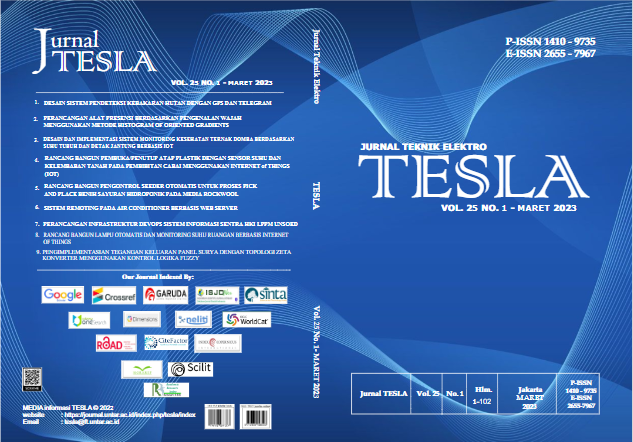RANCANG BANGUN LAMPU OTOMATIS DAN MONITORING SUHU RUANGAN BERBASIS INTERNET OF THINGS
Main Article Content
Abstract
From time to time, electricity consumption continues to increase rapidly. The current average growth in electricity consumption is 2.3-2.5%, and by the end of 2030, it is estimated that the need for electrical energy will be twice the current one, which is around 16,000 TWh per year. Small things that have often been done so far, maybe without us realizing it has had a big impact and if it continues to be done it will result in a scarcity of electrical energy. This can happen because of a consumptive lifestyle that is wasteful and inefficient. This consumptive behavior towards electrical energy can change patterns and lifestyles to become more wasteful. The problem of wasting electrical energy is 80% caused by humans and 20% is caused by technical factors, this is due to excessive and untimely use of electricity. One solution to this problem can be overcome by using Internet of Things technology. In this project, an automatic lamp design is made using a PIR sensor, LDR sensor, and DHT11 temperature monitoring with nodeMCU and Blynk, to increase the efficiency of electricity use at home. Automatic light is a system that can control lights automatically according to needs. The PIR and LDR sensors will detect the presence of movement and darkness in the room, so the lights will only turn on when needed. In addition, this system also has a temperature monitoring feature that can monitor room temperature in real time which can be accessed by the Blynk application. With this system, users can save more electricity and avoid fires due to lights that are constantly on. This article produces a prototype of an automatic light control device and room temperature monitoring and an application design that can already be installed on Android. Based on testing of the PIR and LDR sensors, the sensor can work at a distance of 5 meters down and the tool functions properly. The DHT11 sensor can also function and read the temperature in the room and display the value in the application
ABSTRAK:
Penggunaan daya terus meningkat dengan cepat dari waktu ke waktu. Pada akhir tahun 2030, diperkirakan kebutuhan energi listrik akan meningkat dua kali lipat dari saat ini, atau sekitar 16.000 TWh per tahun, dengan rata-rata peningkatan tahunan sebesar 2,3-2,5%. Tindakan kecil yang sering dilakukan di masa lalu, mungkin tanpa kita sadari, telah memberikan dampak yang signifikan, dan jika terus berlanjut akan menyebabkan kekurangan energi listrik. Gaya hidup konsumtif yang boros dan tidak efektif dapat menyebabkan hal ini. Penggunaan energi listrik yang tidak efisien ini dapat mengubah perilaku dan kehidupan serta menjadikannya boros. Karena penggunaan daya yang berlebihan dan tidak teratur, orang bertanggung jawab atas 80% masalah pemborosan energi dan elemen teknologi 20% darinya. Salah satu solusi dari permasalahan tersebut dapat diatasi dengan menggunakan teknologi Internet of Things. Pada proyek ini dibuat rancang bangun lampu otomatis memanfaatkan sensor PIR, sensor LDR, dan monitoring suhu DHT11 dengan nodeMCU dan Blynk, untuk meningkatkan efisiensi penggunaan listrik di rumah. Lampu otomatis merupakan sistem yang dapat mengontrol lampu secara otomatis sesuai dengan kebutuhan. Sensor PIR dan LDR akan mendeteksi keberadaan gerakan dan kegelapan di ruangan, sehingga lampu hanya akan menyala jika diperlukan saja. Selain itu, sistem ini juga memiliki fitur monitoring suhu yang dapat memantau suhu ruangan secara realtime yang bisa di akses diaplikasi Blynk. Dengan sistem ini, pengguna dapat lebih hemat listrik dan terhindar dari kebakaran akibat lampu yang terus menyala. Pada artikel ini menghasilkan sebuah prototipe alat pengendali lampu otomatis dan monitoring suhu ruangan dan desain aplikasi yang sudah bisa dipasang di android. Berdasarkan pengujian sensor PIR dan LDR, sensor dapat bekerja pada jarak 5 meter ke bawah dan alat berfungsi dengan baik. Sensor DHT11 pun dapat berfungsi dan membaca suhu diruangan serta menampilkan nilainya pada aplikasinya
Article Details
Section

This work is licensed under a Creative Commons Attribution-ShareAlike 4.0 International License.
This work is licensed under a TESLA: Jurnal Teknik Elektro Creative Commons Attribution-ShareAlike 4.0 International License. 
Notice: Deprecated: The template at plugins/themes/bootstrap3/templates/plugins/generic/citationStyleLanguage/citationblock.tpl has moved and will not be found in the future. in /var/www/html/lib/pkp/classes/plugins/Plugin.php on line 468
How to Cite
References
P. A. Dahono, “Menghemat energi Dengan Menggunakan Listrik,” 7 Maret 2011. [Online].
E. "Pemborosan Energi 80 Persen Faktor Manusia," 27 April 2011. [Online]. Available: https://www.esdm.go.id/en/media-center/news-archives/pemborosan-energi-80-persen-faktor-manusia.
M. A. A. N. Rostini, E. and A. P. Junfithrana, "APLIKASI SMART HOME NODE MCU IOT UNTUK BLYNK," Jurnal Rekayasa Teknologi Nusa Putra, pp. 1-7, 2020.
A. "Apa itu NodeMCU V3 & Fungsinya dalam IoT (Internet of Things)," 22 February 2020. [Online].
A. "Modul Sensor PIR HC-SR501," 29 Oktober 2013. [Online].
Y. m. and A. f. , "LIGHT DEPENDENT RESISTANT (LDR) SEBAGAI," Jurnal JUPITER, pp. 39-45, 2016.
S. R. Fikri, A. J. Lubis and R. L. , "Sistem Kendali Lampu Taman serta Pengecekan Suhu dan Kelembapan di Sekitar Menggunakan NodeMCU ESP8266 Berbasis Internet Of Things," SNASTIKOM, pp. 253-260, 2021.
M. S. and M. H. , "RANCANG BANGUN SISTEM KEAMANAN RUMAH," Jurnal Teknologi Elektro, Universitas Mercu Buana, pp. 87-94, 2017.
A. "Mengenal aplikasi BLYNK untuk fungsi IOT," 23 November 2017. [Online].

